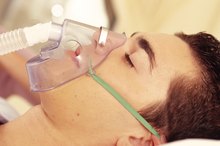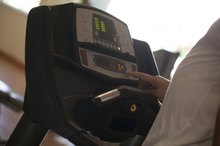How to Set Up the Flow Meter on a Oxygen Concentrator
The air in earth's atmosphere contains about 21 percent oxygen and 79 percent nitrogen, along with other gases. By filtering nitrogen and other gases from air, an oxygen concentrator allows you to breath pure oxygen, either through an oxygen mask or a cannula, a plastic tube with prongs that fit into your nostrils 4. An oxygen concentrator helps you receive extra oxygen if you have heart or lung disease, anemia or injuries like burns. Your lungs transfer the oxygen to your blood, which carries the oxygen to all of the cells in your body. Your body needs oxygen to run efficiently and for survival.
Turn the oxygen concentrator dial of the flow meter until you see the metal ball rise on the flow meter scale to the numeric level recommended by your doctor or caregiver, if the flow meter uses a metal ball. Turn the dial counterclockwise to lift the ball to the correct number, increasing the oxygen flow, and clockwise to lower the ball, decreasing the oxygen flow. The flow meter is located on the front of the oxygen concentrator.
How to Change Oxygen Cylinders Safely
Learn More
Center the metal ball on the line next to the number prescribed by your doctor. The flow meter controls how fast oxygen is released from the oxygen concentrator or oxygen tank in liters per minute (LPM), typically represented by numbers ranging from 0 to five.
Turn the dial of the oxygen concentrator flow meter directly to the number recommended by your doctor or caregiver if your model uses a numbered dial or a needle flow meter.
Warnings
Never smoke or let other people smoke around your oxygen. Because oxygen causes rapid burning or combustion, it can cause a fire to spread quickly in your home. Keep your oxygen concentrator away from gas stoves, open flames and other heat sources as well. Keep a working a fire extinguisher nearby.
Leave immediately and call 911 if a fire breaks out in your home. Tell the fire department you have oxygen in the house. (See Reference 2)
Never set the flow meter to a higher flow rate without permission from your doctor or caregiver. A higher flow rate will deliver too much oxygen, which may be dangerous if you have certain medical conditions, such as heart disease, congestive heart failure, pulmonary hypertension, emphysema, and asthma. (See Reference 3 & 4)
Related Articles
References
- Drugs.com: Using Oxygen Safely
- Rowan University: Respiration
- Drugs.com: Using Oxygen at Home
- Bnet: Oxygen bars: Is a Breath of Fresh Air Worth It?
- Things to Know When Using Oxygen Therapy. American Lung Association. August 23, 2018
- The Long-Term Oxygen Treatment Trial Research Group. A Randomized Trial of Long-Term Oxygen for COPD with Moderate Desaturation. The New England Journal of Medicine. 2016;375(17):1617-1627. doi:10.1056/NEJMoa1604344.
- American Lung Association. Supplemental Oxygen. 2017.
- Shah SA, Velardo C, Farmer A, Tarassenko L. Exacerbations in Chronic Obstructive Pulmonary Disease: Identification and Prediction Using a Digital Health System. Eysenbach G, ed. Journal of Medical Internet Research. 2017;19(3):e69. doi:10.2196/jmir.7207.
- Turan O, Ure I, Turan PA. Erectile dysfunction in COPD patients. Chron Respir Dis. 2016;13(1):5–12. doi:10.1177/1479972315619382
- Traveling with Oxygen. American Lung Association. October 3, 2018
- Nishimura M. High-flow nasal cannula oxygen therapy in adults. J Intensive Care. 2015;3(1):15. Published 2015 Mar 31. doi:10.1186/s40560-015-0084-5
- Abdo WF, Heunks LM. Oxygen-induced hypercapnia in COPD: myths and facts. Crit Care. 2012;16(5):323. Published 2012 Oct 29. doi:10.1186/cc11475
- American Thoracic Society. Patient Education Information Series. Oxygen Therapy. 2016.
Warnings
- Never smoke or let other people smoke around your oxygen. Because oxygen causes rapid burning or combustion, it can cause a fire to spread quickly in your home. Keep your oxygen concentrator away from gas stoves, open flames and other heat sources as well. Keep a working a fire extinguisher nearby.
- Leave immediately and call 911 if a fire breaks out in your home. Tell the fire department you have oxygen in the house. (See Reference 2)
- Never set the flow meter to a higher flow rate without permission from your doctor or caregiver. A higher flow rate will deliver too much oxygen, which may be dangerous if you have certain medical conditions, such as heart disease, congestive heart failure, pulmonary hypertension, emphysema, and asthma. (See Reference 3 & 4)
Writer Bio
Chyrene Pendleton has been a business owner and newsletter editor for more than seven years. She is a freelance writer with over 25 years experience and teaches a variety of topics, including alternative health, hair care and metaphysics. Pendleton is a certified television show producer, radio talk-show host and producer, and a computer programmer with a bachelor's degree in computer science.








